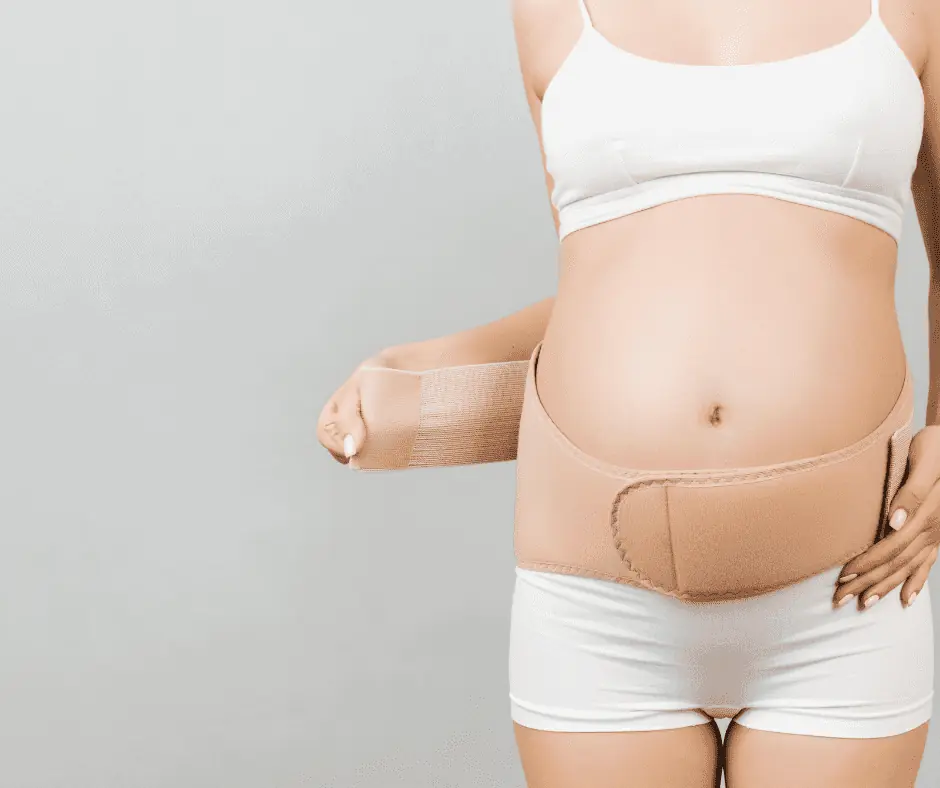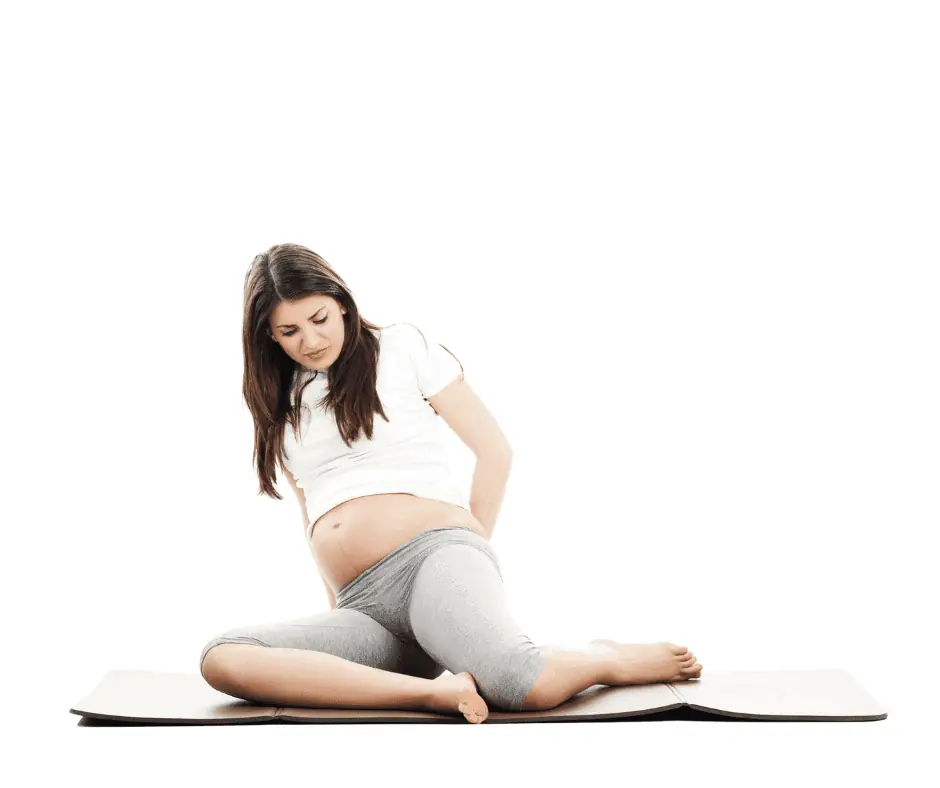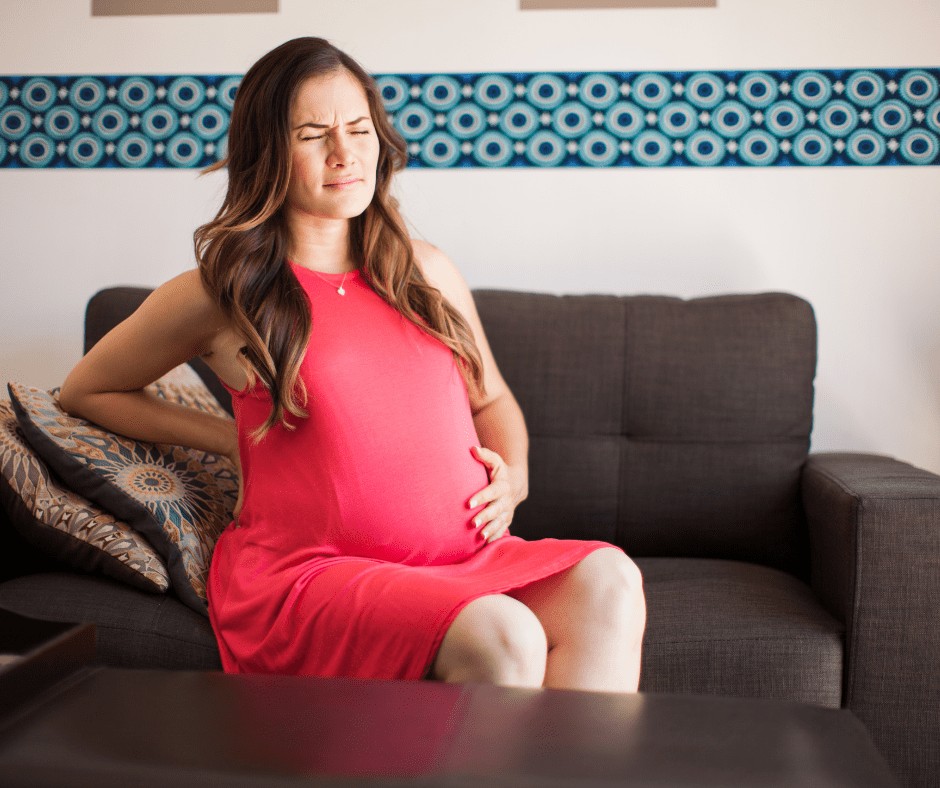How to Deal with SI Joint Pain During Pregnancy
This post may contain affiliate links. As an Amazon Associate, I earn from qualifying purchases.
If you’re pregnant and experiencing SI joint pain (and have found yourself Googling “SI joint pain pregnancy”)- you’re not alone. This type of pain is very common during pregnancy. The good news is that there are ways to deal with it effectively.
In this blog post, we will discuss what the SI joint is, what causes pain, and how to combat it effectively. So if you’re pregnant and struggling with SI joint pain, read on for some helpful advice from a mom and physical therapist!
My Own Experience and Expertise with SI Joint Pain During Pregnancy
When I was pregnant with my first daughter, I was still working full-time at a nursing home as a physical therapist. I was on my feet all day and started experiencing some major SI joint pain near the end of my second trimester. Some days, I found myself limping around the hallways wondering how I was going to get through my day.
I was worried it would get worse and worse as my belly grew, but thankfully I found some tricks that helped me manage my pain. It never went away completely until after I gave birth, but it did become significantly more manageable with the tips I will share below. I highly recommend these both as a mom whos been there and a doctor of physical therapy that wants you to get pain relief!
Good luck mama! And remember it should pass as your body changes and you have your baby!
What is an SI Joint?
There are two sacroiliac joints (SI joints) where the back of the pelvis and the spine come together in the lower body. They are located on each side of the low back under the dimples of the low back (each known as the posterior superior iliac spine or PSIS).
They are responsible for shock absorption and transferring weight between the upper body and lower body. Dysfunction in the core, spine or SI joints themselves can lead to sacroiliac joint pain and other pelvic girdle pain- particularly in pregnant women.

What Causes Joint Pain During Pregnancy?
There are a lot of factors that can contribute to the onset of SI joint pain in pregnancy.
1. Hormone Changes
The hormone relaxin is released during pregnancy to allow the pelvis to open- making room for a growing baby and allowing childbirth. However, it leads to increased laxity and potential instability in the SI joints, which can cause pelvic pain or sacroiliac joint pain in pregnancy with daily activities and postures.
These changes can cause sacroiliac joint dysfunction and pain even in the first trimester, before the next two factors below come in to play.
2. Growing Pressure
As the baby grows and the belly expands, there is more internal pressure on the SI joint. This can also contribute to pain.
3. Biomechanical Changes
Finally, the weight gain- primarily in the belly- that comes with pregnancy changes the way weight is distributed in the lower back, pelvic floor, and SI joints. (It can also change your posture and lead to neck pain.)
Plus, it often leads to a change in mechanics (such as the iconic pregnancy “waddle”) that put different levels of stress directly on the joints, muscles, and ligaments in this sensitive area.
Symptoms of Sacroiliac Joint Dysfunction
There are a few different signs that you may have SI joint dysfunction.
One common symptom is a pain in the lower back or buttocks (on one side or both) that feels worse with prolonged sitting, standing, or when getting up from a seated position. Additionally, many pregnant women report that this type of pain gets worse at night and can interfere with sleep due to an inability to get comfortable.
Other common symptoms of SI joint pain or dysfunction include:
- Pain that ranges from mild to severe, and dull and achy to sharp
- Clicking or popping in the SI joint
- A feeling of instability or “giving way” in the SI joint
- Difficulty walking or standing for long periods of time
Is It Really SI Joint Pain?
Especially during pregnancy, there are so many major changes going on in your pelvis that it can be hard to blame one specific joint or tissue on pain.
Other common causes of pain during pregnancy include :
- Round ligament pain: As the baby grows, the round ligaments that support your pelvis and connect to your uterus stretch. This can cause sharp pains or aching in the lower abdomen or groin. The pain is usually worse when you move suddenly, get up from sitting or lying down, cough, or sneeze.
- Pubic symphysis pain: The pubic symphysis is the joint in the front of your pelvis. It also starts to loosen during pregnancy due to the relaxin hormone and can cause pain in the pelvic girdle, groin or lower back.
- Hip pain: The hips also play a key role in weight distribution. Thus, changes in the way you are standing walking, and performing daily activities with increased weight strain can lead to pain and dysfunction.
- Low back pain: The growing baby and extra weight lead to a change in your center of gravity and posture, which can put added stress on your lower back (lumbar spine) – even tailbone pain – and lead to pain.
Get Professional Help
So how do you know if you’re experiencing SI joint pain or something else? It’s hard to tell unless you talk to a health professional. If you have concerns and want some advice for management, talk to a physical therapist.
How to Combat Joint Pain During Pregnancy
Luckily, the majority of SI joint pain cases will resolve on their own after the baby is born and relaxin levels go back to normal. (Note: your hormones will still be “off” postpartum while breastfeeding too.) In the meantime, there are a few things you can do to ease your pain.

Get Moving
Exercise is a great way to combat SI joint pain and an important part of a healthy pregnancy. Low-impact activities, such as walking, swimming, and gentle stretching can help to increase blood flow and reduce stiffness. Just be sure not to overdo it or put too much stress on your joints. Primarily, focus on moving your body as symmetrically as possible (aka- not single leg balance) to avoid overstraining one side.
Do Hip and Core Specific Exercises
Increased laxity in the pelvis can accentuate any underlying strength and coordination issues within the core. Targeted exercises can help provide pain relief via circulation and help build awareness around how you’re using your core muscles with daily activities.
Let’s review some of my favorite exercises for SI joint pain.
Try each one for up to 10 to 20 repetitions and 2 to 3 sets today. Modify your range and intensity to keep your SI joint pain as manageable as possible. If they feel good, do them daily. Otherwise, shoot for at least 3 times per week.
- Pelvic tilts: This is a great movement to start with for SI joint pain or pelvic girdle pain. It can be done lying down, sitting, or standing. The key is to focus on tilting your pelvis back and forth while keeping your upper body relatively still and in a balance posture (no leaning or slouching).
- Banded hip abduction: In sitting, tie a band around your knees. Then, gently pull your legs away from each other. Make sure the return to your starting position is slow and controlled.
- Seated hip adduction: With a ball or pillow between your legs in sitting, gently squeeze and hold for 5 seconds at a time.
- Hip bridges: Lying on your back with your feet flat on the ground and shoulder-width apart, push through your heels to raise your hips off the ground. Keep your torso and thighs in one straight line. Keep your range of motion small to relatively pain-free.
- Bird-dogs: Start on all fours with your hands directly below your shoulders and knees below your hips. Maintain a flat back as you reach one arm forward and the opposite leg back. Return to the starting position and repeat on the other side. If it’s too difficult, focus on just one limb at a time.
- Mini squats: Start standing with your feet slightly wider than shoulder-width apart and toes pointing forward (or slightly outward). Keeping your knees behind your toes, send your hips back and down as if you were going to sit in a chair. Keep the motion small. Return to the starting position.
- Child’s pose stretch: Start on all fours with your wrists under your shoulders and knees under your hips. As you exhale, sit back on your heels and lower your forehead to the floor. You can also place a pillow or block under your head for support. (For more yoga poses, look here!)
Ultimately, the key with all these exercises is to use the muscles of your pelvis and lower back gently to strengthen and promote mobility. When you do this, your body will thank you in more ways than one (less constipation, pain, weight gain, etc.)! If these don’t feel comfortable, it’s best to modify until they do or talk to your physical therapist about other treatment options.
Safety notes:
- I thought I couldn’t lie on my back? In general, it is not recommended to lie on your back due to the risk of impeding blood flow to the baby. If you are lying on your back for a moment before doing an exercise, it’s generally considered safe. However, always talk to your doctor about any concerns and before starting any new exercise.
- Is pain okay with exercise? Pain may slightly increase while exercising. However, it should stay manageable. If your pain becomes severe, lingers throughout the day, or increases significantly (and suddenly), you need to modify or stop.
Use Modalities for Short-Term Pain Relief
Applying heat or ice to the sore areas can help temporarily relieve pelvic pain and reduce inflammation.
Just be careful not to put ice directly on your skin or use heat for more than 20 minutes at a time. Also, avoid putting heat directly on your belly or using it so long that you feel overheated.
If your pain is constant and significantly affecting your daily activities, you might also consider electrical stimulation. I recommend talking to your doctor first about this option though to make sure it is safe for your pregnancy.
Recognize Postures That Are Flaring Up Your Pain
This might seem obvious, but it is the easiest way to manage your pain during pregnancy. I can’t stress enough that if a movement hurts- it needs to be modified or avoided- at least for the time being. It doesn’t mean you need to be afraid of moving, but having some awareness here can make all the difference.
For example, in my second pregnancy, we bought a new home when I was 7 months pregnant. We were painting the rooms and I was attempting to help- but I noticed every time I bent down to paint anything below my waist level I’d be limping around the rest of the day due to sacroiliac joint pain. Needless to say, I stopped painting below my hips and recruited other family members to help me with the lower portions. 🙂
Examples of postures and movements that tend to be aggravating and lead to pelvic pain:
- Lying on your side without a pillow between the legs
- High impact movement- such as running and jumping
- Single leg activities
- Standing on one leg or shifting to one side for an extended amount of time (often seen as “popping the hip out”)
- Sitting for too long- particularly on a hard surface
- Reaching overhead repetitively

Try an SI Belt
If you are in your second or third trimester and pelvic girdle pain or SI joint pain is consistently keeping you from activities you enjoy, an SI belt can be a game-changer. Applying external support to the area helps take some of the load off of the ligaments surrounding your SI joint, provides some stability, and can ultimately help decrease pain.
You have two primary options to try:
- Sacroiliac Belt: Make sure it adjusts from both sides for an even supported fit.
- Belly Support Band: For more generalized support of the lower back and pelvis.
As with all things pregnancy related, listen to your body. If the support is causing discomfort, is too constricting or isn’t alleviating your pain, don’t continue using it.

The Bottom Line
As a pregnant woman, there are some major changes happening in your body that affect alignment, strength, and tissue laxity. That’s why pain is so common throughout pregnancy as your body adjusts. While some pain may feel inevitable and part of life as a pregnant mom, it’s important to know that you don’t have to suffer unnecessarily.
Making a few simple changes to your daily routine can make all the difference in coping with your pain in preparation for delivery, postpartum, and beyond. Plus, taking a proactive approach now can also prevent the risk of chronic pain once your baby is born too.
I hope these tips help you. Daily exercise and the use of an SI belt helped me the most. What about you? What did I miss? I’d love to hear in the comments below!
If you want more professional advice, feel free to email me at [email protected] too- I’m always here for you!







